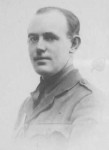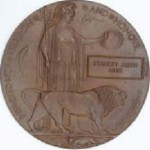MUIR, Stanley Keith
Stanley Keith Muir was born at Ascog, Orrong Road South, Elsternwick on 8 April 1892. He was the youngest child of John Franklin Muir and his wife, Josephine, nee Holmes. He had two brothers and four sisters. John was a banker and at one time was manager of the Land Mortgage Bank. In 1896 the family moved to Jolimont, to a house which they renamed Ascog, at 26 [now 60] Jolimont Street, a single storied house with bay window, now demolished. Rate books list John Muir at Jolimont Street until 1909, yet Stanley, when he enlisted, gave his father as his next of kin and his address as 28 Jolimont Street, so it appears that, after the death of his wife and when his children left home for work or marriage, John moved next door to a two storey terrace house, still standing, renting a room or apartment.
Stanley was at Scotch College in 1900 when he was second in the under 10 150 yards. He was at Melbourne Grammar in 1907 but left due to illness. War Service Old Melburnians 1914-1918 tells us more about his early life:
[his illness] eventually developed into hip disease. He was for six months on his back and another six months on crutches, but gradually grew out of his trouble, and after a long sojourn on Gulpha Station in Riverina was completely cured. He was a well known amateur rider at picnic races in the Deniliquin district, and was a very fine horseman.
He enlisted on 20 August 1914. He was 5ft 7½ins, 10 stone 3lbs, with a dark complexion, brown eyes and brown hair. He gave his religion as Presbyterian, and his occupation Station Overseer. He had had military experience in 29th Light Horse. He was appointed to A Squadron, 4th Light Horse Regiment at Broadmeadows as a private.
He embarked on 19 October 1914 aboard the Wiltshire and disembarked in Egypt on 10 December. Stanley missed much of the action at Gallipoli due to illness. He was admitted to hospital at Mena with rheumatism on 24 March 1915 and was transferred to the convalescent camp in Abbassia on 25 April 1915, the day of the first landings. He did not rejoin his unit at Anzac until 27 July 1915, in time for the Battle of Lone Pine (6-10 August) where, according to newspaper reports, he was wounded. However this is not mentioned in his service record. He was promoted to Corporal on 13 August 1915. He was admitted to hospital a second time on 28 August 1915 and invalided to Malta on 31 August, again with rheumatism or rheumatic fever. In September he was moved from Malta to London with ‘enteric’ (presumably enteric fever or typhoid). He was discharged on 30 October for furlough. All in all, it appears he only spent a month at Gallipoli.
In England he was discharged from AIF due to receiving a commission in the 20th Service Battalion (B.E.L. Pioneers), Kings Royal Rifles Corps on 17 November 1915. He was given the rank of temporary 2nd Lieutenant. He had had no crimes, no forfeitures nor had he contracted VD during his time in the Light Horse.
But soon he changed course again and applied for a position with the Royal Flying Corps. He gained his wings in May at Military School, Catterick Bridge, and was posted to 67 (Australian) Squadron [later No. 1 Squadron], Royal Flying Corps at Heliopolis on 27 July 1916. Initially this squadron was mainly involved in aerial reconnaissance but soon became “‘jack of all trades’ carrying out reconnaissance, photography, ground attack and liaison missions, in addition to having to fight off aggressive German adversaries”. It was based at Kantara. On 22 December 1916 Stanley took part in action which earned him the Military Cross. The recommendation reads:
Temporary 2nd Lieutenant Stanley Keith MUIR, No. 67 (Australian) Squadron, Royal Flying Corps
For conspicuous dash and skill on 22nd December, 1916. In the attack on TEL-EL-SHARIA BRIDGE [15 miles north of Beersheba], he dropped his bombs from a low height and very accurately. In addition he afforded great assistance to the machine photographing BIR SABA during the same flight, by skilful fighting. He was mainly instrumental in shooting down a Fokker, which he followed down from 10,000 fee to 2,000 feet.
Further, on the 1st January, 1917, he, single handed, pursued two enemy machines from EL ARISH to BIR SABA, one of which flew to the south, and the other he drove down over its own aerodrome, coming down to 3,000 feet to do so.
During the chase he was under the enemy observer’s fire for 10 minutes, but with great coolness held his fire until within 70 yards and must have inflicted severe damage on the enemy machine. He then waited over BIR SABA under heavy A.A. fire for the other machine, which flew in shortly afterwards, diving so fast to earth that he was unable to attack it.
His ordinary work has been excellent.
Michael Molkentin in his book, Fire in the Sky, gives this description:
After lunch, ten BE2cs from No.1 Squadron (joined by another two from No. 14 Squadron) prepared the way by dropping more than a hundred 20lb bombs on the Turkish positions at Magdhaba. ................. Over the target, three German scouts attacked the formation. Watching from 1000 feet above, Muir in his brown and white Martinsyde picked out a Fokker monoplane and dived. He chased it down, firing off two whole drums. ‘I was very close,’ he recalled, ‘at times only a few feet apart.’ Turning away to load a third drum, Muir saw his quarry make for the ground and land roughly on a rugged wady floor. The other German pilots broke off and the raiders returned unharmed.
In January 1917 he transferred to 68 Squadron which embarked at Alexandria for England for training on 13 January 1917 aboard the Kingstonian. He disembarked at Southampton on 30 January 1917. The 68 Squadron was equipped initially with de Havilland DH-5 aircraft, and its main role was to escort larger, slower aircraft, seek out and destroy the enemy’s aircraft, and provide support for ground troops.
Where Muir was or what he was doing for the next few months is not explained in his war service record; the unit history is equally blank and the unit diaries do not start until September 1917. Yet newspapers later reported that he made several trips to France. It was reported in the papers in May 1917 that he had been appointed Flight-Commander.
His service record resumes on 18 August 1917 when it was noted that he marched into Harlaxton from overseas. Less than four weeks later he was killed in a tragic accident on 12 September, only days before the squadron was to leave for the Western Front. He was on a training flight, flying a DH-5, and coming in to land at Harlaxton aerodrome, where the squadron was based, and at 500 feet a wing snapped off the plane, which plummeted to earth, killing Muir instantly.
He was buried with full military honours in the churchyard of SS Mary and Peter, Harlaxton, Lincolnshire, UK. He is remembered in the Australian War Memorial's Commemorative Roll, but is not recorded on the Roll of Honour as he was not serving with the Australian Armed Forces.
Kiddle, J. Beacham, War Service Old Melburnians, 1914-1918 (1918)
Molkentin, Michael, Fire in the Sky, The Australian Flying Corps in the First World War, Allen & Unwin (2013)
City of Melbourne, Albert Ward, Rate Books, 1895-1914
Can you help?
Can you correct or provide more information about this person?
Or are you able to help with this history project?
- Family stories and records including photos, documents and memorabilia?
- Stories or information in books, newspapers and on-line?
- Memorial plaques in churches and public places?
- War memorial, church, national and state archives?
If so, please Contact the East Melbourne Historical Society.


